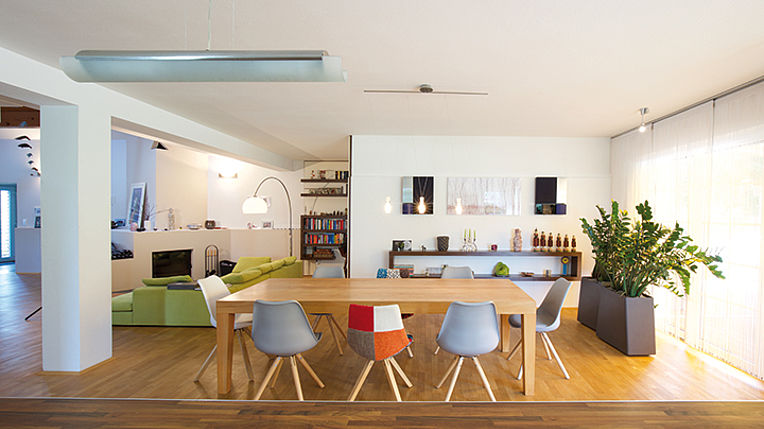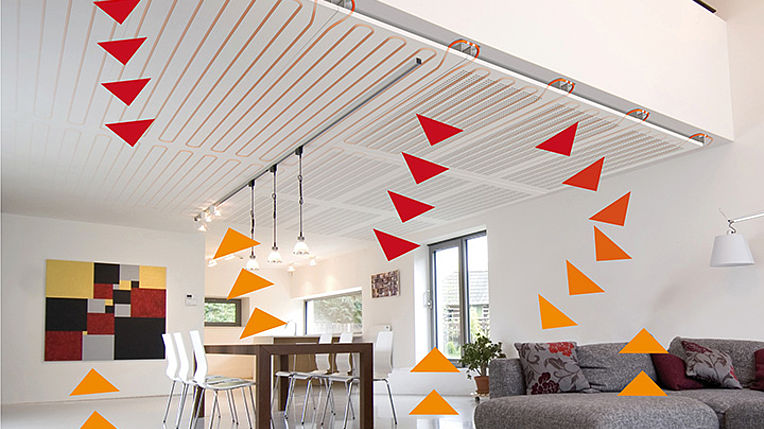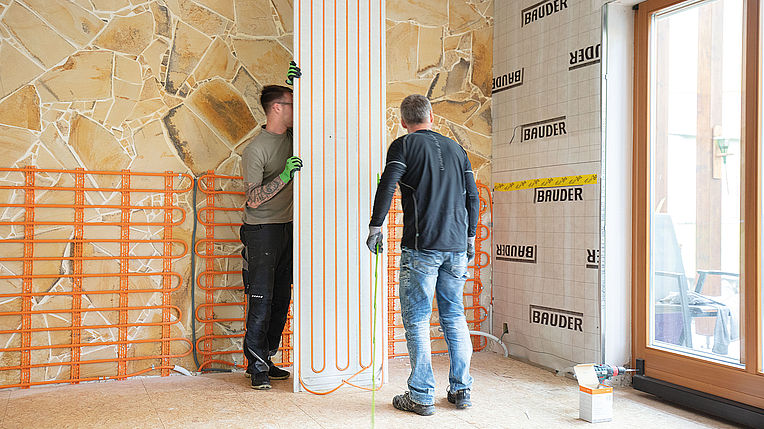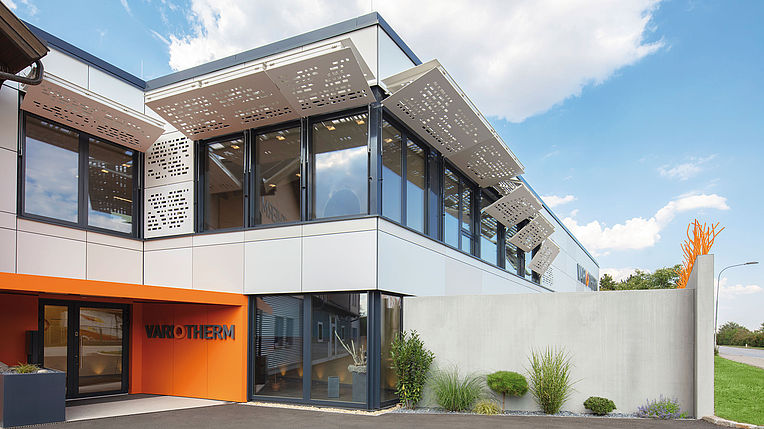An overview of cooling systems – alternatives to air conditioning
The periods of hot weather during the summer are becoming longer and more extreme. The sultry nights make it difficult to sleep. Cooling is needed! But does it have to be air conditioning? Why not cool via the ceiling or walls? We’ll show the best alternatives to air conditioning.
Surface cooling versus air conditioning: the differences
Unlike air conditioning, surface cooling does not blow cold air into the room. Instead, it cools via the walls or ceiling using radiant exchange, which means that the room is free of forced air and the risk of dust circulation and bacteria is minimal. For allergy sufferers in particular, this means a better quality of life. Surface cooling is silent, and can be run at night.
The healthy, room climate-friendly alternative requires less energy than air conditioning systems. If the ceiling or wall is used for cooling, the room already feels comfortable at temperatures of around 26 °C, thanks to the exchange of radiant heat. Find out more about comfort and warmth in the room.
By comparison, if air conditioning is used to cool the room, the room temperature must be cooled down to around 23 °C in order to achieve the same comfort effect. Every additional degree of room temperature saves ten percent energy costs. This makes it possible to save up to 30 percent on energy with water-bearing surface cooling.
Ceiling or wall cooling also means more freedom to design the rooms how you want. Surface cooling is invisibly installed in the ceiling or walls and leaves plenty of free space for the interior architecture.
Surface cooling via the ceiling or walls
There are various ways of tempering your rooms using surface cooling:
Ceiling cooling
The all-rounder! Rooms can be cooled via the ceiling during the summer. Thanks to radiant exchange, this is done without using forced air. If the ceiling cooling is mounted with a noise-absorbing surface, it also reduces the reverberation, making it ideal for offices and public buildings. And the best thing: in the winter, the rooms can be heated using the same system.
Wall cooling
With wall cooling the heat stays outside in the summer! Thanks to radiant exchange, excess heat is drawn out of the human body. The person in the room feels comfortable. Wall cooling also saves on up to 30% of energy costs compared to standard air conditioning units. The added bonus: the walls remain free, giving you the freedom to design the room how you want.
Partial cooling via the floor
If you want to cool via the floor, you’ll quickly reach the limits of what is possible with high thermal loads. Since we are in direct contact with this surface, we react particularly sensitively to the temperature there. If the floor is too cool, we feel uncomfortable.
How does cooling via the ceiling and walls work?
Cooled water flows through the installed pipes at a temperature of around 16 °C, and cools the surfaces. The person in the room emits the excess heat to the cooling ceiling or cooling walls via the surrounding atmosphere. The walls and ceiling absorb the heat and conduct it out of the room. A comfortable climate is created in the room that feels like standing in the shade of a large tree.
In summary: unlike standard air conditioning systems, surface cooling cools the human body, and not the air.
Retrofitting surface cooling
As a drywall construction system, ceiling cooling or wall cooling can be retrofitted whenever you want. The gypsum fibre boards, which have been certified as ecologically safe, are screwed onto a substructure made of wood or metal. The joint adhesive on the edge connects the panels. The cooling pipes, which are laid in the rear side, are connected to the cooling and heating manifold. The surface is then filled and painted, and the cooling and heating ceiling is ready to use.
Surface cooling in drywall construction is particularly suitable for listed buildings, and in rooms where the original floor is to be preserved.
Cooling in summer, heating in winter
The same system that is used to cool the room in the summer via the walls or ceiling can be used to heat it in the winter. For surface cooling and surface heating, you need the right energy source. With a heat pump or a cold water set, you can switch between cooling and heating at just a click of a button.
Advantages and disadvantages of surface heating and cooling
- No bothersome air conditioning units on the walls.
- Free of forced air – does not blow dust into the air.
- Silent – can also run at night.
- A comfortable room climate thanks to heat exchange.
- The temperature can be regulated individually for each room.
- Saves up to 30% energy costs.
- Maintenance-free.
- 10-year guarantee.
- A cooling ceiling or cooling wall is more expensive to buy than an air conditioning system. However, during ongoing operation, the energy costs of a water-based ceiling cooling system are up to 30% lower than the electricity costs of an air conditioning unit. In this way, the cost of surface heating and cooling pays off after just a few years. With added comfort as an extra benefit!
- You should not put large furniture in front of cooling surfaces on the walls, since this impairs the heating and cooling performance. However, there are more options available for designing the room. Hanging pictures on a cooling wall is not a problem, although you do need to take care and locate the aluminium multi-layer composite pipe beforehand using the pipe locator or thermofoil.
How does surface cooling work?
Cooled water flows through the installed pipes at a temperature of around 16 °C, and cools the surfaces. Via the surrounding atmosphere, the person in the room emits the excess heat to the cooling ceiling and cooling walls, which then absorb it and conduct it out of the room.
Is it possible to retrofit ceiling cooling?
As a drywall construction system, ceiling cooling and wall cooling can be retrofitted. The ModulePanels with the integrated cooling pipe are screwed directly onto the substructure. This surface cooling system is also suitable for listed buildings and rooms where the original floor is to be preserved.
What are the advantages of ceiling and wall cooling?
Cooling via the ceiling or walls means that you enjoy many benefits of surface cooling. Thanks to radiant exchange, the room climate stays comfortable all year round. Surface cooling cools the room without using forced air, and does not cause dust circulation. It is silent, and can be run at night.
![[Translate to English:] Flächenkühlung als Alternative zur Klimaanlage [Translate to English:] Flächenkühlung als Alternative zur Klimaanlage](/fileadmin/_processed_/9/8/csm_Flaechenkuehlung_Modulplatten_c_variotherm_929f57bc8e.jpg)
![[Translate to English:] Flächenkühlung mit angenehmer Strahlungsenergie [Translate to English:] Flächenkühlung mit angenehmer Strahlungsenergie](/fileadmin/_processed_/7/4/csm_Strahlungsenergie_Kuehlung_02b93142de.jpg)






